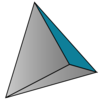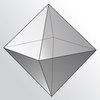A Fraction Ahead Review Flashcards
This deck of flash cards will review some of the topics covered during A Fraction Ahead, along with some extras
In geometry, what does congruent mean?
Two shapes that are identical in every way

What is a regular polygon?
A polygon whose side lengths are all equal, and whose angles measurements are all equal

What is a Platonic solid?
A 3 dimensional shape whose faces are congruent regular polygons, with the same number of faces meeting at each vertex
How many Platonic solids exist, and what are their names?
5: Tetrahedron, Cube, Octahedron, Dodecahedron, Icosahedron

What shapes are the faces of a tetrahedron, and how many faces does a tetrahedron have?
Triangles with 4 faces

What shapes are the faces of a cube, and how many faces does a cube have?
Squares with 6 faces

What shapes are the faces of an octahedron, and how many faces does an octahedron have?
Triangles with 8 faces

What shapes are the faces of a dodecahedron, and how many faces does a dodecahedron have?
Hexagons with 12 faces

What shapes are the faces of an icosahedron, and how many faces does an icosahedron have?
Triangles with 20 faces

What are some of Plato’s most popular philosophical ideas?
What is the formula for the addtion of numbers from 1 to a natural number n?

How do you derive the formula for the addtion of numbers from 1 to a number n?
What symbol is used to describe a factorial?
!
How do you calculate a factorial?
Multiply each number in descending order up until 1. Example: 4! = 4x3x2x1 = 24
What does a factorial tell us?
How many ways you can order a certain amount of objects
How many ways can you order a deck of cards?
52! ways, or approximately 8.0658175e+67 ways
Is 52! a large number?
Yup
Just how big is 52!?
If the video starts at the beginning, the explanation starts about 14 minutes in.
What is this symbol called, and what does it represent?

It is a “blackboard bold” N, and it represents the set of natural numbers
Which numbers are included in the set of natural numbers?
{1, 2, 3, 4, …}. The “…” means this goes on forever. Some mathemeticians include 0 in the natural numbers.
What does this symbol represent?

The set of integers
Which numbers are contained within the set of integers?
{…, -2, -1, 0, 1, 2, …}










